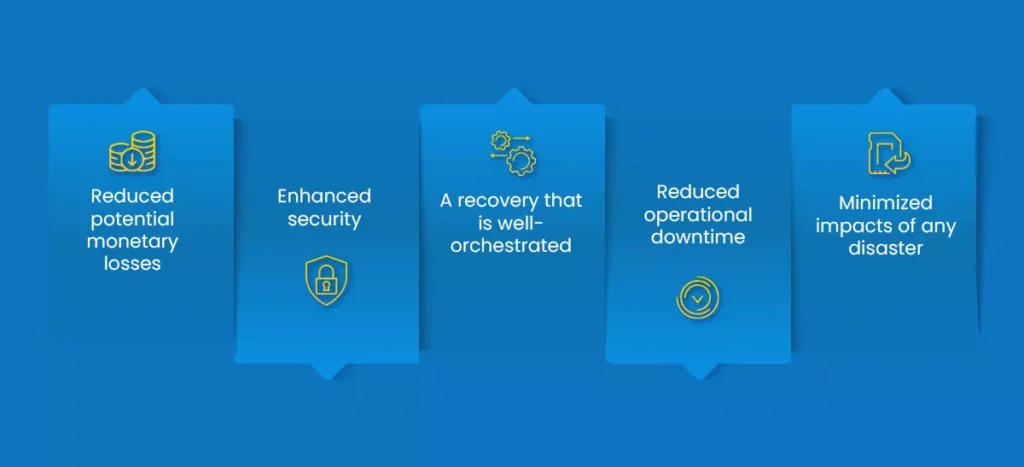Seamless operations are vital in the highly competitive Banking, Financial Services, and Insurance (BFSI) sector. Any disruption caused by a natural disaster, cyber-attack, or hardware failure can have significant consequences. That’s where Disaster Recovery (DR) comes into play. DR is restoring critical systems and data after a disruptive event, which is crucial for maintaining business continuity in BFSI.
However, traditional disaster recovery approaches may not be sufficient to combat today’s evolving threats and data demands. This is where Managed Services for Disaster Recovery (MSDR) step in. This blog post will explore the importance of managed services for disaster recovery in BFSI and learn how they safeguard businesses from unforeseen disruptions.
Contents
Challenges in BFSI Disaster Recovery
challenges in BFSI Disaster Recovery:
- Complexity of IT Infrastructure: BFSI organizations often have intricate IT systems, including legacy applications and new technologies, which can complicate disaster recovery planning and execution.
- Data Security and Privacy Concerns: sensitive nature of financial data requires stringent security measures, making it challenging to ensure data privacy during disaster recovery processes.
- Downtime and Business Continuity: Minimizing downtime and maintaining seamless business continuity can be difficult to achieve due to complex interdependencies.
- Evolving Cyber Threats: The financial sector faces ever-changing cyber threats, and disaster recovery plans must constantly evolve to address new vulnerabilities and attack vectors.
- Compliance and Regulatory Requirements: Meeting the stringent regulatory demands of the BFSI industry during disaster recovery can be a complex task that requires careful planning and documentation.

Figure 3: Why opt for disaster recovery services?
Image source: esds.co.in
Key Components of Managed Services for Disaster Recovery
Real-time Data Backup and Replication
Data is the lifeblood of any BFSI institution, and continuous access to critical information is paramount. Managed services ensure real-time data backup and replication to remote, secure locations. This redundancy guarantees that operations can swiftly switch to the replicated site without significant disruptions, even if one data center is affected.
Redundancy and Failover Solutions
To minimize single points of failure, MSPs implement redundancy and failover solutions. These mechanisms enable automatic switching to backup systems in case of hardware or software failures, ensuring uninterrupted services.
Consider a scenario where a server failure occurs during peak trading hours at a bank. With a failover mechanism, the services can seamlessly switch to a secondary server, preventing financial losses and maintaining customer satisfaction.
Continuous System Monitoring and Automated Alerts
Timely detection of anomalies is critical to mitigating potential disasters. Managed service providers employ robust monitoring tools that constantly track the health of the IT infrastructure. Automated alerts promptly notify IT teams about irregularities, allowing them to take proactive measures before issues escalate. For example, if unusual network traffic is detected, the MSP can immediately investigate the matter and potentially thwart a cyber-attack before it causes significant damage.
Implementing Managed Services for Disaster Recovery in BFSI
1: Risk Assessment and Business Impact Analysis
Before implementing managed services for disaster recovery, BFSI businesses should perform a detailed risk assessment. Organizations can prioritize their disaster recovery efforts by identifying potential threats and their impacts.
2: Designing the Disaster Recovery Strategy
Based on the risk assessment and business impact analysis, BFSI institutions can develop a comprehensive disaster recovery strategy. This plan outlines the steps in various disaster scenarios, including data restoration and system recovery procedures.
3: Choosing the Right Managed Service Provider (MSP)
Selecting the appropriate MSP is critical. Look for an MSP with expertise in the BFSI sector and a proven track record in disaster recovery services. A reliable MSP will also have comprehensive Service Level Agreements (SLAs) to guarantee minimal downtime and maximum data recovery.
4: Setting up Data Backup and Replication
Collaborate with the chosen MSP to establish real-time data backup and replication processes. Determine which data needs to be replicated and how often, ensuring critical information is continuously updated in a secure off-site location.
5: Implementing Redundancy and Failover Mechanisms
Work with the MSP to set up redundancy and failover solutions for essential systems and applications. This could involve redundant hardware, load balancing, and automated failover mechanisms to ensure seamless continuity of services.
Conclusion
Managed Services for Disaster Recovery are crucial in ensuring business continuity in the BFSI sector. By identifying potential threats, implementing proactive measures, and staying compliant with regulations, Financial Institutions can safeguard their operations from disruptions. Embracing the latest trends in disaster recovery, like cloud-based solutions and AI-driven automation, will further strengthen their resilience and readiness to face future challenges.
With STL’s Managed Services for Disaster Recovery in BFSI, rest easy knowing that your disaster recovery plan complies with strict security and regulatory standards while benefiting from cost-effective solutions and enhanced scalability. With the right managed services provider and a well-defined disaster recovery strategy, BFSI businesses can confidently navigate adversity and emerge stronger.
Managed services achieve this by implementing real-time data backup and failover mechanisms. These measures ensure that critical data is continuously backed up and accessible, even during disasters, leading to uninterrupted business operations.
Managed service providers adhere to strict security and compliance standards. By partnering with them, BFSI institutions can rest assured that their disaster recovery plan meets all the regulatory requirements, such as GDPR or PCI DSS.
Managed Services for Disaster Recovery in BFSI offer cost-effective solutions by providing the option to outsource disaster recovery to a Managed Service Provider (MSP). This approach is often more economical than building and maintaining an in-house solution, and upskilling existing teams, allowing businesses to allocate resources efficiently for critical tasks.
Managed services provide increased scalability and flexibility in disaster recovery by allowing BFSI institutions to scale their recovery capabilities up or down based on their evolving business needs. This adaptability ensures the disaster recovery plan can grow and change with the business’s operations.















